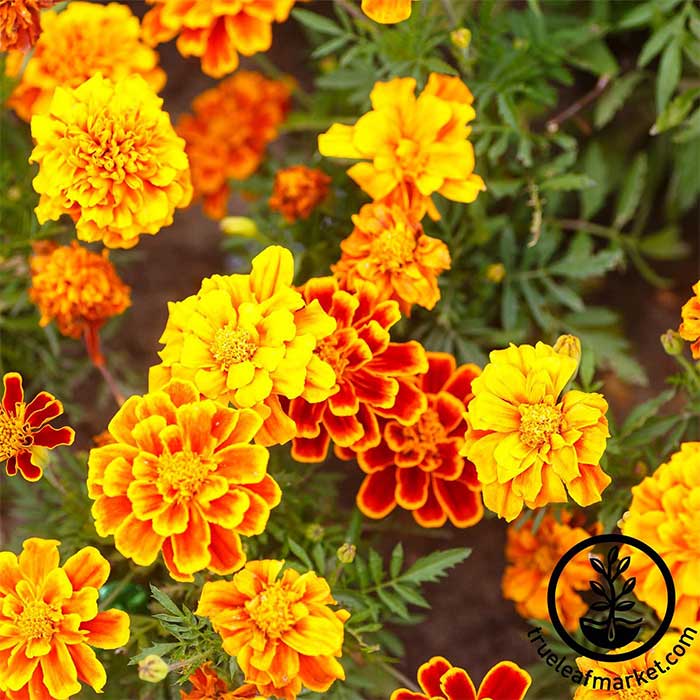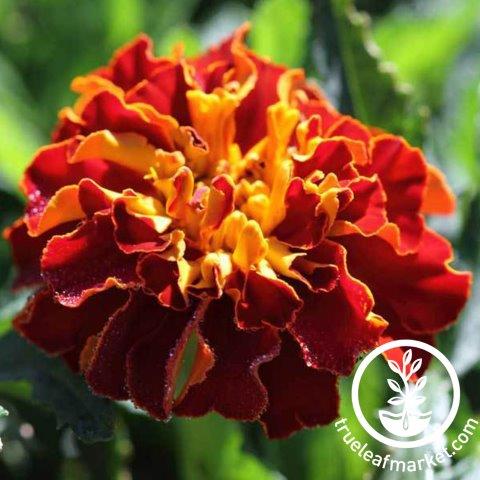 |
Written By Lara Wadsworth |
In the vibrant tapestry of the botanical world, few flowers can match the exuberance and versatility of marigolds. These cheerful blossoms have enchanted gardeners for centuries with their vivid hues and distinctive aroma. In this exploration, we delve into the world of marigolds, uncovering their fascinating characteristics, cultural significance, and the myriad of ways they can enhance your garden.
A Floral Overview: The Marvelous Marigold
Marigolds, scientifically known as members of the genus Tagetes, belong to the Asteraceae family. This diverse group includes sunflowers and daisies. Native to the Americas, these resilient flowers have been cultivated and cherished across the globe for their beauty and beneficial properties in ornamental and edible gardens.
Marigolds come in various species, each possessing unique attributes. The two primary categories are Tagetes erecta (African marigold) and Tagetes patula (French marigold). African marigolds are tall and majestic, boasting large, showy flowers suitable for cutting. French marigolds are more compact, with smaller blooms. The Tagetes tenuifolia (Lemon or signet marigold) is known for its finely divided, aromatic foliage. Tagetes lucida is commonly known as Mexican Mint or Mexican tarragon for its flavor. Lastly, there is Calendula officinalis, also known as Common or Pot Marigold. This flower is actually a member of the Asteraceae family (related to daisies) and is native to parts of Europe and Africa.
One of the most appealing aspects of marigolds is their vibrant color spectrum. Ranging from sunny yellows and oranges to deep reds, marigolds add a burst of warmth to any garden. Some varieties even exhibit bi-color or multi-color patterns, creating a visual feast for the eyes.
Popular African Marigold Seed Varieties
Popular French Marigold Seed Varieties
Cultural Significance of Marigolds
Beyond their aesthetic appeal, marigolds hold cultural significance in various societies, rituals, ceremonies, and traditional practices of cultures worldwide.
Day of the Dead
In Mexico and other Latin American countries, marigolds are integral to the Dia de los Muertos (Day of the Dead) celebrations. During this time, families create altars adorned with marigold flowers, believing that the vibrant colors and fragrant aroma help guide the spirits of the departed back to the world of the living.
Hindu Ceremonies
Marigolds are also highly regarded in Hindu culture. They are often used in religious ceremonies and festivals, symbolizing auspiciousness and positive energy. The vibrant orange and yellow hues are associated with the sun, radiating positivity and joy.


Medicinal Uses
Traditional medicine has long recognized the therapeutic properties of marigolds. The flowers contain compounds with anti-inflammatory and anti-microbial properties, making them valuable in treating various skin conditions, wounds, and inflammation. Marigold extracts are frequently used in herbal remedies and ointments.
Growing Marigolds: Tips for Success
Cultivating marigolds is a gratifying experience, whether you are a seasoned gardener or a novice with a green thumb in the making. Here are some essential tips to ensure success in growing marigolds:
- Choose the Right Variety - Select marigold varieties based on your garden's needs and your preferences. African marigolds are excellent for borders or as background plants, while French marigolds thrive in containers, hanging baskets, or edging plants.
- Sunlight Requirements - Marigolds are sun-loving plants that thrive in full sunlight. Ensure they receive at least 6-8 hours of direct sunlight daily. Placing them in well-lit areas will result in robust growth and prolific flowering.
- Well-Drained Soil - Marigolds prefer well-drained soil with a slightly acidic to neutral pH. Amending the soil with organic matter, such as compost, enhances fertility and drainage. Avoid waterlogged conditions, as marigolds are susceptible to root rot in overly damp soil.
- Watering Routine - While marigolds are relatively drought-tolerant, consistent watering is essential, especially during dry spells. Water the plants at the base to keep the foliage dry, reducing the risk of fungal diseases. Once established, marigolds are quite resilient in varying moisture conditions.
- Deadheading for prolonged Blooms - Regular deadheading – the removal of spent flowers – encourages continuous blooming. This simple practice redirects the plant's energy from seed production to the formation of new buds, resulting in a longer flowering season.
- Companion Planting - Marigolds are aesthetically pleasing and serve a practical purpose in the garden. Their strong fragrance is a natural deterrent for certain pests, making them excellent companion plants. Interplanting marigolds with vegetables or other susceptible plants can help protect them from nematodes and additional harmful insects.
- Container Gardening - French marigolds, with their compact size, are well-suited for container gardening. Plant them in decorative pots or hanging baskets to adorn balconies, patios, or windowsills. Container gardening allows for easy mobility and flexibility in arranging these delightful flowers.
Marigolds in the Kitchen: Culinary Delights
Beyond their ornamental value, marigolds offer an unexpected treat for the culinary enthusiast. Edible marigold petals can elevate salads, desserts, and beverages, infusing a subtle citrusy flavor and a splash of color to your culinary creations.
Edible Blossoms
French marigolds, in particular, are known for their edible blossoms. The petals have a slightly spicy, tangy taste, making them a unique addition to salads or a garnish for soups and desserts. Ensure the flowers are grown organically and pesticide-free before incorporating them into your culinary adventures.
Floral Teas
Infuse your tea with a touch of marigold magic. Dried marigold petals can be steeped to create a fragrant, soothing tea that not only tantalizes the taste buds but also offers potential health benefits, thanks to the flower's anti-inflammatory properties.
Colorful Ice Cubes
Freeze marigold petals in ice cubes for a visually stunning addition to your beverages. Whether you're serving lemonade, iced tea, or cocktails, these floral ice cubes add a touch of elegance and a burst of color.
Marigolds, with their vibrant hues, cultural significance, and multifaceted uses, stand as a testament to the wonders of the natural world. Whether gracing your garden with its radiant presence, contributing to cultural traditions, or surprising your taste buds in the kitchen, marigolds are a botanical treasure that continues to captivate and inspire. So, embrace these sun-kissed blooms and let the marigold's enchantment unfold in your own green haven.
 |
Lara Wadsworth, True Leaf Market Writer |
I am a native of Southwestern Michigan, where I also reside, and I love all things plants! I got a Bachelor's Degree in Horticulture and found the first work-from-home job I could get. Now, I spend my days writing for TLM, playing with my dog, eating delicious food with my husband, and plotting my next landscape or gardening move. I believe everyone should get down and dirty in the soil now and then. Happy Gardening!



























0 comments
No comments yet! Be the first to start a conversation.